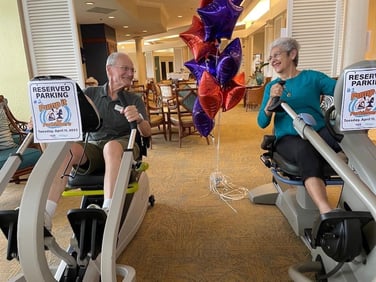 Last year, the only complaint we heard about Pump it for Parkinson’s was several communities heard about it too late and missed out on the fun! 2023 was the first year the National Institute for Fitness and Sport (NIFS) hosted the event to raise awareness on the benefits of exercise for those fighting back against Parkinson’s Disease and by all accounts it was a smashing success!
Last year, the only complaint we heard about Pump it for Parkinson’s was several communities heard about it too late and missed out on the fun! 2023 was the first year the National Institute for Fitness and Sport (NIFS) hosted the event to raise awareness on the benefits of exercise for those fighting back against Parkinson’s Disease and by all accounts it was a smashing success!
- Over 4 million total steps on the NuStep cross trainer were accumulated by senior living communities across the US far exceeding our goal of 1 million steps.
- 100% of event survey responses reported Pump it engaged their residents and staff in a fun new way and created buzz within their community!
- 100% of event surveys reported their residents were pumped to contribute to a Parkinson’s focused event!
As we gear up for year number two, we are going even bigger with new goals, new recruiting efforts to engage more communities, and an optional fundraising element. Here are the basics of what Pump it for Parkinson’s is and how communities can get involved.
Pump it is an event on World Parkinson’s Day where communities can rally their residents and staff to contribute steps on their NuStep cross trainer to submit towards NIFS nationwide goal. Registration is free and participating locations receive a digital toolkit of educational resources, signage and tracking sheets to help them promote and host the event in their community. Hosting Pump it for Parkinson’s is a great way to engage your residents and staff in wellness, contribute to a nationwide goal and help your residents who are impacted by Parkinson’s feel recognized. At the end of the day, communities submit their total step count to NIFS and we tally up all the hard work from thousands of residents and staff across the US who contributed! One thing we heard repeatedly from communities last year is they were surprised to learn how many residents and staff were directly impacted by Parkinson’s Disease and how many residents kept their diagnosis hidden. Pump it empowered many individuals to share their story!
The one-day event will be hosted on Thursday, April 11, 2024, and here are our big goals for this year:
- We are aiming for 10 million total steps to honor the 10 million people living worldwide with Parkinson’s Disease! Rally your residents, staff, families, and prospects to contribute steps on as many NuSteps your community has available. This a great program to engage residents across the continuums if you are a lifeplan community by recruiting your activities and rehab staff in licensed areas to participate! Our motto, every step counts and it’s a great way to help residents of all abilities contribute.
- Due to requests, we are also proud to announce a partnership with Team Fox to incorporate an optional fundraising element for the Michael J. Fox Foundation for Parkinson’s Research (MJFF)! Communities can form or a team or individual donations can be made if desired.
- We are inviting senior living operators to make a Pump it Pledge by recruiting as many of your communities to participate in this free event as possible. We will recognize your organization’s commitment to resident well-being through future blogs and social announcements featuring our participating locations. Contact Emily Davenport for more information on creating your organization’s Pump it Pledge!
Not only do communities have an opportunity to participate in an engaging event, but they also have a chance to win a free NuStep T6 Cross Trainer thanks to our partners at NuStep and a kit of Parkinson’s fitness resources from NIFS to enhance their wellness program.
Visit our event page to register: https://wellness.nifs.org/pump-it-for-parkinsons and follow along at Pump it for Parkinson’s Facebook page for great tips, images, and inspiration for a successful event. We would also like to extend a thank you to our event partners who are committed to helping us spread the word about Pump it for Parkinson’s including NuStep, Wellzesta and ICAA. If you are a vendor in the senior living space willing to help us spread our message, please reach out here for more information on how you can help.


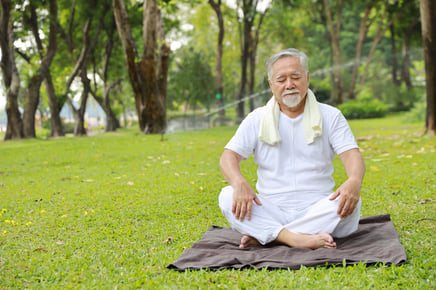 It has often been thought that core strength can only to be achieved through sit ups, crunches, and planks but in recent years there has been a lot more discussion about the way we breathe and how it effects our core. If you participate in 1-1 training or group fitness, you have probably heard your trainer tell you to breathe and brace your core through a particular exercise. What does it mean to effectively brace your core and why is it important? Is it to see your abdominals, provide you strength or to help with your posture? In all reality, we use our core for many daily tasks such as standing tall, getting up off a chair, or even walking. Learning how to brace your core is fundamental in creating a strong foundation for all movements and can also help to aide in injury prevention.
It has often been thought that core strength can only to be achieved through sit ups, crunches, and planks but in recent years there has been a lot more discussion about the way we breathe and how it effects our core. If you participate in 1-1 training or group fitness, you have probably heard your trainer tell you to breathe and brace your core through a particular exercise. What does it mean to effectively brace your core and why is it important? Is it to see your abdominals, provide you strength or to help with your posture? In all reality, we use our core for many daily tasks such as standing tall, getting up off a chair, or even walking. Learning how to brace your core is fundamental in creating a strong foundation for all movements and can also help to aide in injury prevention.
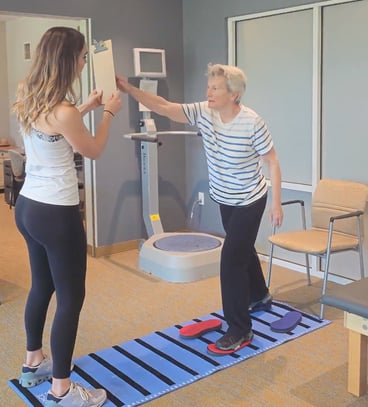 Every senior living community offers group fitness classes. If you want to stand out from the competition, you have to offer more.
Every senior living community offers group fitness classes. If you want to stand out from the competition, you have to offer more.
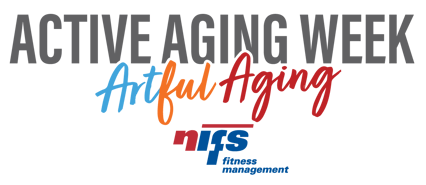 As the seasons change and leaves take on vibrant hues of red, yellow, and orange we are reminded that much like an artist, we can craft our lives in beautiful ways, and what better time to celebrate that reminder with our senior residents than during Active Aging Week? Active Aging Week, celebrated annually, shines a light on the importance of maintaining an active and engaged lifestyle as we age. This year, at NIFS, we’ve decided to focus on “aging artfully” and help the residents in the communities that we partner with age well through embracing their creativity.
As the seasons change and leaves take on vibrant hues of red, yellow, and orange we are reminded that much like an artist, we can craft our lives in beautiful ways, and what better time to celebrate that reminder with our senior residents than during Active Aging Week? Active Aging Week, celebrated annually, shines a light on the importance of maintaining an active and engaged lifestyle as we age. This year, at NIFS, we’ve decided to focus on “aging artfully” and help the residents in the communities that we partner with age well through embracing their creativity.
.jpg?width=461&height=307&name=GettyImages-1432465103%20(1).jpg)
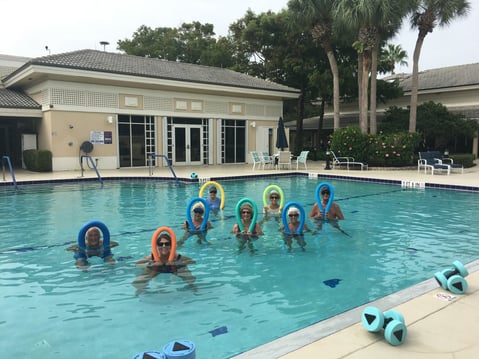 When you were a kid, going out to play was something you likely did every day. No matter if it was riding a bike, skipping rocks at the pond, or running around the neighborhood with friends, it was just fun! Moving came naturally and easy and was not considered “exercise” to the adolescent mind even though it was most certainly keeping your body healthy. The reason I bring this up is because I want you to think about those times. They were a lot of fun, weren’t they? Sometimes in our fitness center, we will hear a member say that exercise isn’t very fun. We get it! Exercise isn’t everyone’s cup of tea, but as a fitness professional, my goal is to find a way to make it fun for you. Another thing we will often here is “I’m not as young as I was!” or “I can’t do that type of movement anymore.” It is true, with the play you did as a child, there was probably a lot of falling, bumps, and bruises and that can make a person apprehensive to get started in “play” again. But that is why we are here, to explore with you and find a form of fitness that you enjoy. Yes, the several number of changes that tend to happen to the body as it goes through the stages of life can make some things more difficult, but we want to help keep it from being the reason you decide to play less.
When you were a kid, going out to play was something you likely did every day. No matter if it was riding a bike, skipping rocks at the pond, or running around the neighborhood with friends, it was just fun! Moving came naturally and easy and was not considered “exercise” to the adolescent mind even though it was most certainly keeping your body healthy. The reason I bring this up is because I want you to think about those times. They were a lot of fun, weren’t they? Sometimes in our fitness center, we will hear a member say that exercise isn’t very fun. We get it! Exercise isn’t everyone’s cup of tea, but as a fitness professional, my goal is to find a way to make it fun for you. Another thing we will often here is “I’m not as young as I was!” or “I can’t do that type of movement anymore.” It is true, with the play you did as a child, there was probably a lot of falling, bumps, and bruises and that can make a person apprehensive to get started in “play” again. But that is why we are here, to explore with you and find a form of fitness that you enjoy. Yes, the several number of changes that tend to happen to the body as it goes through the stages of life can make some things more difficult, but we want to help keep it from being the reason you decide to play less.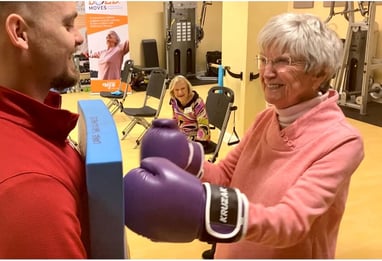 The prevalence of Parkinson’s Disease is on the rise. Previous numbers indicated that 60,000 Americans are diagnosed each year and
The prevalence of Parkinson’s Disease is on the rise. Previous numbers indicated that 60,000 Americans are diagnosed each year and 
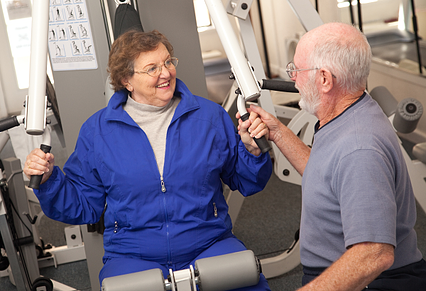 We work on a lot of build/design projects in retirement communities where the project is either new construction for a new community, or the plan is part of a repositioning that includes enhanced wellness spaces and services. If you follow industry trends, you see it all the time in press releases, RSS feeds and other media avenues: ground breakings for projects that include a state-of-the-art wellness wing, indoor/outdoor pool complex, etc. Communities are serious about folding resident wellness into their broader business strategy to remain viable in the market. Over my years at NIFS, I’ve had the pleasure of working on dozens of fitness center builds. As you can imagine, I’ve learned quite a bit along the way. Below are our top five recommendations (in random order) on pitfalls to avoid during your design journey.
We work on a lot of build/design projects in retirement communities where the project is either new construction for a new community, or the plan is part of a repositioning that includes enhanced wellness spaces and services. If you follow industry trends, you see it all the time in press releases, RSS feeds and other media avenues: ground breakings for projects that include a state-of-the-art wellness wing, indoor/outdoor pool complex, etc. Communities are serious about folding resident wellness into their broader business strategy to remain viable in the market. Over my years at NIFS, I’ve had the pleasure of working on dozens of fitness center builds. As you can imagine, I’ve learned quite a bit along the way. Below are our top five recommendations (in random order) on pitfalls to avoid during your design journey.
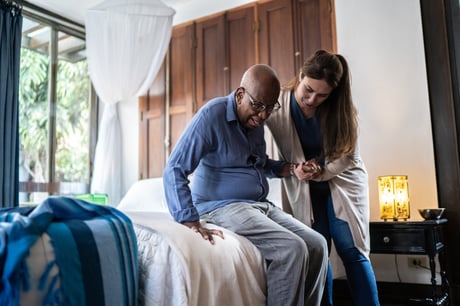 In sharing the many benefits of living in a senior living community with seniors, I often receive the response “I want to live in my home as long as I possibly can”. Making sure you are active and healthy can improve your life to maintain that desire to remain in your home. Below are 4 tips to consider before making that important decision.
In sharing the many benefits of living in a senior living community with seniors, I often receive the response “I want to live in my home as long as I possibly can”. Making sure you are active and healthy can improve your life to maintain that desire to remain in your home. Below are 4 tips to consider before making that important decision.
.jpg?width=455&height=303&name=GettyImages-516160511%20(1).jpg) Gratitude is the quality of being thankful. It is showing appreciation for giving and receiving acts of kindness. Performing acts of kindness has many benefits to our health, both mentally and physically. When we practice gratitude, we improve our daily wellbeing and overall happiness. Gratitude helps us with our mindset. We learn how to be more positive and be kinder to ourselves and others. We want to treat other people the way we want to be treated. This increases everyone’s sense of happiness which in return improves our health.
Gratitude is the quality of being thankful. It is showing appreciation for giving and receiving acts of kindness. Performing acts of kindness has many benefits to our health, both mentally and physically. When we practice gratitude, we improve our daily wellbeing and overall happiness. Gratitude helps us with our mindset. We learn how to be more positive and be kinder to ourselves and others. We want to treat other people the way we want to be treated. This increases everyone’s sense of happiness which in return improves our health.